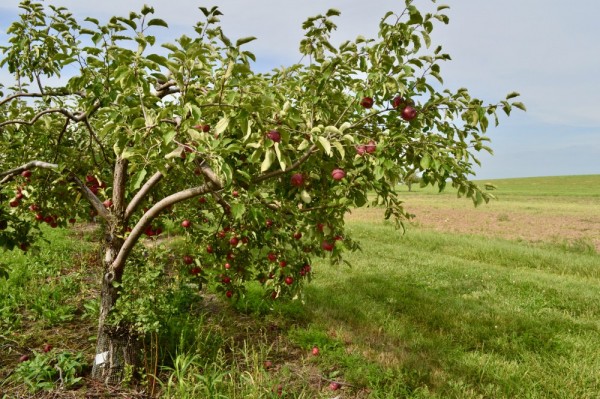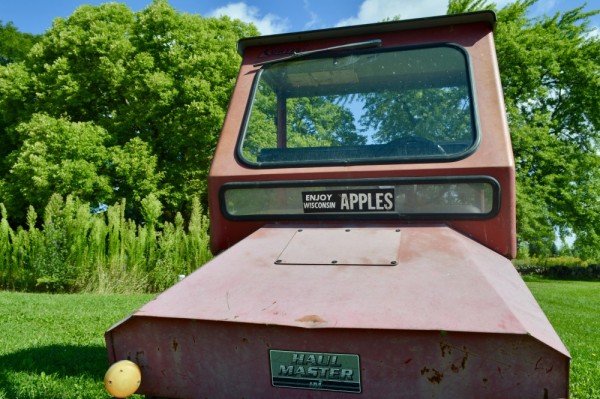What does the Fox say? An apple a day
Sharon Haen’s grandmother recommends a Wealthy apple – more sweet than tart – to bake the best pie. Sharon and her husband Darrell purchased Star Orchard in 2013; today it merges the intersection of rural and urban life.
“A lot of people like to show their children where apples come from, instead of the grocery store,” Haen says. “We take picking apples for granted, but many children and adults have never done it.”
Just outside the town limits of Hollandtown, Wisconsin, the orchard’s 55 acres have been in the family for over half a century. Generations of visitors can flock to its fields, yet still find a quiet corner to pick apples: 20 varieties from over three thousand trees.
“Except in winter, when all we do is prune trees…, every day is a bit different,” Haen says. “There’s a lot of mowing and monitoring the trees to keep them healthy… This time of the year, we are getting the store ready and sprucing up the orchard for our visitors.”
It’s just the two Haens taking care of their land, whizzing through the the acres on four-wheelers, but that’s the way they like it: full work days outside, not a single cubicle in sight. Simplicity is key on County Road CE.

A five minute drive around the bend from Kaukauna High School, Star Orchard’s rolling rows contain some of the original trees from 1962.
“We don’t have playground equipment or animals,” Haen says. “We prefer to keep it simple. In fact, when we first purchased the orchard, several people expressed concern that we would start changing it.”
On the other end of the spectrum, The Little Farmer in Malone, Wisconsin extends far beyond branches: it’s an experience. Guests here can pick Cortlands and McIntosh’s, sure, but the orchard and farm market cultivates a broader atmosphere.
“It is a place for people to escape and get out in the country,” Orchard Manager Jeremy Klemp says. “We’re still a farm: we’re 140 acres; there’s not a lot of places people can visit, not a lot of farms that people can visit and just explore the different parts.”
Throughout those 140 acres, the “different parts” consist of a lot more than bushels and pecks. The Apple House contains the the bakery and the caramel apple kitchen, the Farmhouse serves refreshments and gift store knick-knacks, and outdoor activities range from hayrides to the corn maze.
Open to all ages, the Little Farmer appeals to smaller guests – from school tours to family trips – a common theme in the business. Tom Lurvey of Oshkosh’s Rasmussen’s Apple Acres, for instance, finds that his pick-your-own apples make for much more than pies. “People come in, and they say, ‘Oh, I remember my dad used to bring me here when I was a kid,’ so now they’re bringing their children.”

Four acres of more mature trees border seven acres of young newcomers at Rasmussen’s Apple Acres. Its relatively smaller size makes for a serene family afternoon.
Traditions like these come with the territory; at Star Orchard grandparents return with grandchildren to share stories and buy local. These extraordinary spaces down two-lane highways defy classification: neither cityscape nor quite countryside, but timeless either way.
“They’ve been growing apples here since 1904, and back in the 50s, as another way to gain revenue, they decided to try a pick-your-own, and the people really loved that,” Lurvey says. “We’ve got seven trees over on the other side of those there that are over 100 years old.”
Much like Star Orchard, Rasmussen’s keeps it plain and classic: just orderly lines of trees and their sweet scents. While these two orchards hone in on apples alone, the Little Farmer aims to include a little bit of everything.
Around the Valley, however, orchards and their caretakers face a similar “problem” of sorts: apple overload. “When I have a variety that’s coloring all over the spectrum, and the trees are different sizes, and they’re ripening unevenly,” Klemp says. “It’s like I keep trying different ones, and it’s just like, ‘Okay, I’ve had enough,’ you know?”

In 2015 alone, Wisconsin produced 51.5 million pounds of apples, as much a part of the state’s economic landscape as its picturesque scenery and culture.
He just wants to make sure they’re good for the customers, he says with a laugh. Apples – Zestars for Klemp, Cortlands for Lurvey – are snagged for breakfast, snacks and lunch; the taste can get tiresome for some, but the job description never does.
“We prune trees all winter, and when the snow starts to melt and things start to green up – I really appreciate springtime now that much more,” Klemp says. “The blossoms come out of the trees and you get to start to watch the food grow.”
Before maintaining the grove, fall was Klemp’s favorite season. Today, fall feels like inviting strangers into his home: strange but satisfactory when the little ones enjoy his hard work. Spring, though, lets him take a breath of crisp air, see his long hours grow into fruition, and prepare to share his haven all over again.










Leave a Comment